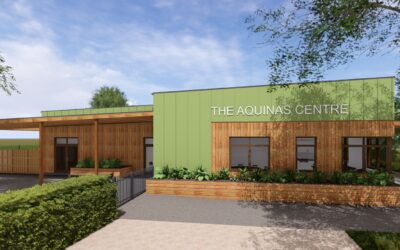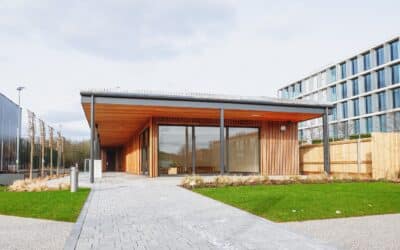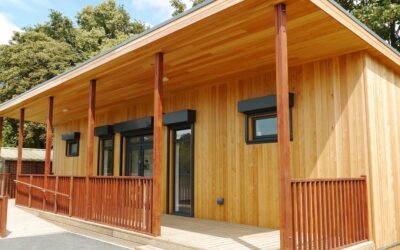TG Escapes Blog
Community Buildings FAQ: Types, Uses, and Funding
Community buildings serve a wide variety of purposes across the UK, often meeting multiple needs at once. From youth centres and village halls to wellbeing hubs and community cafés, these spaces bring people together, support essential services and strengthen local connections.
TG Escapes design and build bespoke modular community buildings with outstanding environmental performance, using sustainable materials and biophilic design principles to create spaces that are flexible, welcoming and built to benefit communities.
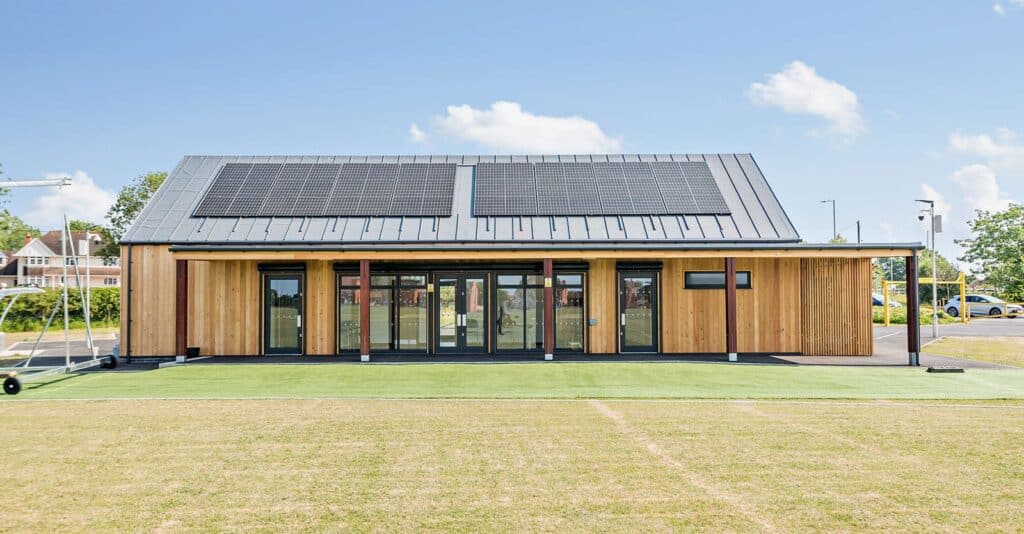
What are community buildings?
A community building is a shared space designed to support the needs of the local area. Often serving as a hub for activities such as classes, meetings, parties, and wellbeing services, community buildings can serve the wider public or be tailored to specific groups.
They take many forms, from purpose-built halls to repurposed schools, religious buildings or commercial premises. Some are publicly funded, while charities or volunteers run others.
What types of community buildings are there?
Community buildings come in many forms, each designed to meet the specific needs of the people they serve. The design and function of a community building will often reflect the identity and priorities of its local area. Here are some of the most common types:
- Village halls and community centres: Typically run by local volunteers or trusts, these spaces host everything from coffee mornings and exercise classes to council meetings and birthday parties.
- Youth centres: A dedicated space for young people, youth centres provide a safe social environment ideal for sport, arts, education and wellbeing.
- Arts and cultural venues: Community theatres and arts centres offer a space for local artists and performers, alongside hosting everything from concerts to pantos.
- Sports and leisure facilities: From local gyms and swimming pools to sports halls and playing fields, these buildings promote physical health and social inclusion. They may be council-run, part of a larger complex, or standalone community assets.
- Community cafés: Run by and for their community, these spaces can provide a range of food and drink to the local area at affordable prices
- Libraries and learning centres: Alongside lending books, libraries provide IT access and a range of community events.
- Multi-purpose community buildings: Multi-purpose buildings are flexible spaces designed to support a wide range of uses under one roof. They may combine meeting rooms, event spaces, office areas and wellbeing services in a single, adaptable layout, maximising both impact and value for local communities.
How to create sustainable community buildings
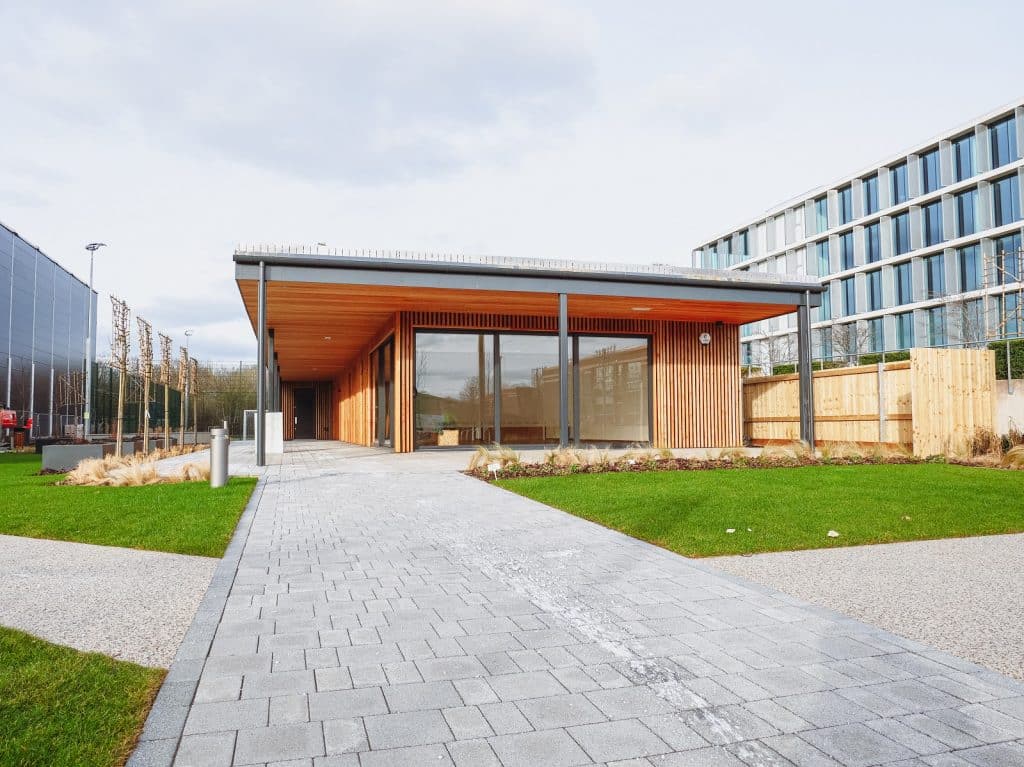
True sustainability requires a commitment throughout the design and build process. At TG Escapes, we design and build community buildings that achieve net zero in operation as standard, by using a fabric-first approach with natural, renewable timber for the frames and panels of our buildings, alongside other measures like recycled insulation and specialist foundations. True sustainability also means planning for the building’s end of life, by ensuring that as many elements as possible can be recycled.
Through features like solar panels, green roofs and high-performance glazing, we reduce energy usage and support biodiversity, while our outdoor spaces and biophilic design principles support wellbeing by connecting users with nature.
Choosing a modular community building
A modular building is one that has been constructed off-site in sections and then assembled on location, offering a quicker, more efficient approach to construction. For community projects, modular solutions provide significant advantages: they’re typically faster to deliver, come at more cost-effective prices, and minimise disruption to local areas.
Modern modular solutions are of an excellent level of quality, with our buildings designed for at least 50 years of regular usage. Another key advantage of our modular system is the large degree of customisation it allows for at the design stage, with our panelised approach particularly suited for truly bespoke multi-use community buildings.
What funding is available for community buildings?
Grants for community buildings
Community buildings may be eligible for a range of grants to support capital improvements, sustainability upgrades, or community development activities. These grants are often targeted at enhancing spaces for local use, increasing accessibility, or improving environmental efficiency. Applications are usually competitive and require a clear demonstration of community benefit, deliverability, and value for money. Match funding is sometimes required.
Find out more on our funding page.
Section 106 community buildings

Section 106 funding can be a crucial tool for funding community buildings. When housing developers are looking to build a large number of new homes in a town, they may have to make a Section 106 agreement with the council to create new community buildings. These agreements help offset the impact of large developments by funding spaces like nurseries, youth centres or multi-use halls.
Developers can either make a financial contribution to the council or directly deliver the building themselves. TG Escapes works with developers across the UK to provide high-quality, sustainable modular buildings that meet Section 106 obligations efficiently and within budget. Our turnkey approach ensures fast delivery and minimal disruption while creating buildings that serve communities for generations. Find out more about Section 106 in our blog.
Our bespoke modular community buildings
TG Escapes designs and builds high-quality modular community buildings for clients across the UK. Every project is designed net zero in operation as standard, achieved through a fabric-first approach using best-in-class heating, cooling and ventilation technology, as well as the use of sustainable timber, recycled insulation and solar panels to create energy-efficient, welcoming spaces. Our full design-and-build service makes the process simple, starting with a free initial design to bring your vision to life. From sports pavilions to wellbeing hubs, our buildings are cost-effective, low-maintenance and built to last.
Here are just a few examples of the community buildings we’ve delivered:
- Sports Pavilion and Dementia Day Centre – Shinfield Parish Council: This dual-use facility serves as both changing rooms for a local sports team and as a day centre for people living with dementia. Built for the local parish council, we received 5* feedback from the client for our work.
- Leisure and Wellbeing Pavilion – Winnersh Triangle Business Park: Offering health and wellbeing facilities for a busy business park, our building offered changing rooms, a kitchen, a treatment room and a yoga studio. It also included a green roof and is surrounded by landscaped gardens and a Gen 2 sports pitch.
Looking to create a bespoke community building?
Every building our team designs and builds is completely tailored to a client’s needs. From small, single-use spaces like cafes to larger multi-purpose community buildings, everything starts with a complementary design service and an upfront price for your finished building.
Speak to a member of our team to find out more.
About the author
More posts from our blog
Education Estates 2025: Surrey County Council Share Their SEND Provision Strategy, Including the Contribution Made by TG Escapes
At the recent Education Estates 2025 conference, I was proud to join Euan Leslie, Programme Manager for our partners Surrey County Council as we presented their ambitious and highly successful strategy for expanding Special Educational Needs and Disabilities (SEND)...
The Benefits of Choosing a Modular Clubhouse Building
A clubhouse needs to serve many functions, from creating social spaces and meeting areas to offering changing rooms and toilet facilities for players. Modular buildings are an ideal solution for creating flexible, purpose-built facilities for sports teams,...
Supporting Active School Life With Modular Sports Pavilions
Physical activity is a crucial part of everyday schooling across the UK. But in many settings, ageing facilities and limited space can prevent pupils from getting the full benefit of PE, sport, and outdoor recreation. Modern sports and leisure pavilions offer an...

